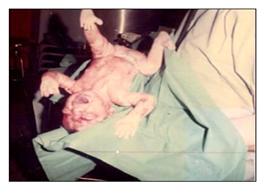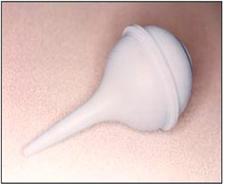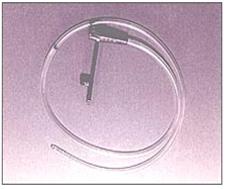신생아의 호흡, Respiration of newborn infants
| 갓 태어난 신생아의 첫째 숨 |
- 태어나기 바로 전까지 자궁 속에 있던 태아의 폐포 속에 공기가 차 있지 않다. 폐포는 공기 대신 양수로 차 있었다. 태아의 폐포 속에 공기가 없었기 때문에 폐는 쪼그라져 있었다.
- 태어나자마자 갓 태어난 신생아들은 본능적으로 입을 크게 벌리고 울면서 공기를 입으로 처음 들이 마신다. 바로 이때 폐포 속에 공기가 처음을 차게 된다.
- 바로 이것이 첫 회분 숨이다.
- 첫 회분 공기를 들이마시면서 전신에서 생성된 이산화탄소가 상·하 기도를 통해 공기 속으로 배출된다.
- 그 이후부터 죽을 때까지 계속 숨을 쉬게 된다.
- 맨 처음 들이마신 공기가 폐포 속으로 들어가면 이제까지 쪼그라져 있던 두 폐가 활짝 펴진다.
- 그 후 신생아 자신이 본능적으로 숨을 계속 쉬게 된다.
- 첫 숨을 쉬기 전 까지는 아기의 기본 생명 유지에 관련된 모든 것은 모체 엄마에게 전적으로 의존하면서 살았다. 이제부터는 아기는 엄마로부터 독립돼서 살아야 하는 아주 작은 한 인간이 됐다.

사진 2-95. 제왕절개수술 분만으로 갓 태어난 신생아가 첫 울음을 터트리면서 첫 숨을 쉬고 있다. 분만실에서 산부인과 의사가 아기를 거꾸로 붙들고 중력에 의해 기도 속의 점액, 양수가 입 밖으로 흘러나오게 하고 있다.
Copyright ⓒ 2011 John Sangwon Lee, MD., FAAP
| 신생아의 정상 호흡수 |
- 건강한 신생아의 정상 호흡수는 1분 30∼40회이다.
- 건강하고 비교적 큰 미숙 신생아의 정상 호흡수는 1분에 30∼60회 정도이다.
- 신생아들은 숨 쉴 때 흉강과 복강 사이에 있는 횡격막을 더 많이 이용한다. 그 때문에 신생아들이 숨을 들이쉬고 내 쉴 때마다 복벽이 정상적으로 위 아래쪽으로 올라갔다 내려갔다 한다.
- 이런 호흡을 복식호흡이라고 한다.
- 갓 태어난 신생아의 호흡수가 1분에 60번 이상이고 숨을 보통보다 자주 쉬면 비정상적이다.
- 비정상적으로 빠르게 쉬는 숨을 빈 호흡이라고 한다.
- 숨을 비정상적으로 빠르게 몇 분 이상 계속 쉴 때는 의사에게 곧 문의해 그 빈 호흡의 원인이 무엇인지 알아보고 그 원인에 따라 치료해야 한다.
| 신생아의 기도 확보, 창백과 청색증 |
- 분만하기 바로 전이나 분만 중, 또는 분만 바로 후 양수, 태변, 또는 산도에서 난 피 등이 갓 태어난 신생아의 비강 속, 입안 속, 인두 강 속, 기관 속, 기관지 속으로 흡인되어 들어갈 수 있다. 그래서 갓 태어난 신생아에게 호흡곤란이 생길 수 있다. 때로는 신생아에게 빈 호흡증도 생길 수 있다.
- 또 심한 호흡곤란이 생겨 산소를 충분히 섭취할 수 없으면 갓 태어난 신생아의 입술, 얼굴, 혀 등 몸 전체가 창백해질 수 있다.
- 더 심하면 피부가 푸르스름하고 중추성 청색증이 전신에 생길 수 있다. 이런 신생아에게 호흡곤란이 있을 때는 응급 진단 치료가 필요하다.
- 신생아들이 태어나자마자 흡입구나 흡입기에 연결된 카세터(Catheter)로 갓 태어난 신생아의 비강 속, 입안 속, 인두 강 속 등에 있는 양수, 태변, 또는 피를 깨끗이 흡인해서 숨통을 열어 기도를 확보해 주어 숨을 정상적으로 쉬게 해야 한다.
- 이런 처치는 출생 후 불과 30초~1분 이내에 해야 한다.

사진 2-96. 갓 태어난 신생아의 입안 속이나 비강 속에 괴어 있는 양수, 태변, 또는 질 산도에서 흡입한 피 등을 흡인할 때 쓸 수 있는 흡인구(Suction bulb)
Copyright ⓒ 2011 John Sangwon Lee, MD., FAAP

사진 2-97. 피딩 튜브(영양관)
아주 작은 저체중 신생아나 미숙아, 또는 어떤 신생아든 자신이 인공영양 등을 입으로 잘 빨아 먹을 수 없 을 때 피딩 튜브를 콧구멍→비강→인두→식도를 통해 위 속에 넣고 그것을 통해 짠 모유나 인공영양 등을 먹일 수 있다. Copyright ⓒ 2011 John Sangwon Lee, MD., FAAP
Respiration of newborn infants 신생아의 호흡
Newborn baby’s first breath
- There is no air in the alveoli of the fetus in the womb just before birth.
- The alveoli were filled with amniotic fluid instead of air.
- The lungs were shrunk because there was no air in the fetal alveoli. As soon as they are born, newborn babies instinctively open their mouths wide and cry and breathe air through their mouths for the first time.
- At this point, the air fills the alveoli first.
- This is the first batch of breath.
- When the first batch of air is inhaled, carbon dioxide generated from the whole body is discharged into the air through the upper and lower airways.
- From then on, they will continue to breathe until they die.
- When the first inhaled air enters the alveoli, the two lungs that had been shrunken so far are opened wide.
- After that, the newborn instinctively continues to breathe.
- Until the first breath, everything related to the maintenance of the baby’s basic life was completely dependent on the mother.
- From now on, the baby has become a very small human being who has to live independently from her mother.

- Photo 2-95. A newborn baby born from a cesarean section is taking her first breath, bursting with her first cry. In the delivery room, the obstetrician holds the baby upside down and causes the mucus and amniotic fluid in the airways to flow out of the mouth by gravity. Copyright ⓒ 2011 John Sangwon Lee, MD., FAAP
Normal respiratory rate in newborns
- The normal breathing rate of a healthy newborn baby is 30-40 times per minute. The normal respiratory rate of healthy and relatively large immature newborns is about 30 to 60 times per minute.
- Newborns use more of the diaphragm between the chest and abdominal cavity when they breathe.
- Because of that, each time the newborns inhale and exhale, the abdominal wall rises and falls normally upwards and downwards.
- This breathing is called abdominal breathing.
- A newborn baby’s breathing rate is more than 60 times a minute, and breathing more often than usual is abnormal.
- Breathing that breathes abnormally quickly is called tachypnea. If you breathe abnormally quickly and continue to breathe for more than a few minutes, you should contact your doctor right away to find out what is causing the empty breath and treat it according to the cause.
The secure airway in newborns, paleness and cyanosis
- Immediately before, during, or immediately after delivery, amniotic fluid, meconium, or blood from the birth canal may be aspirated into the nasal cavity, mouth, pharyngeal cavity, trachea, or bronchi of a newborn baby.
- So, breathing difficulties can occur in newborn babies. Occasionally, newborns can develop cyanosis.
- In addition, if you cannot get enough oxygen due to severe breathing difficulties, the entire body such as the lips, face, and tongue of a newborn baby can become pale.
- In more severe cases, the skin may become bluish and central cyanosis may develop throughout the body. When these newborns have difficulty breathing, emergency diagnostic treatment is needed.
- As soon as the newborn baby is born, a catheter connected to the inhaler is used to cleanly aspirate amniotic fluid, meconium, or blood in the nasal cavity, mouth, or pharyngeal cavity of the newborn baby to open the breathing chamber and secure the airway.
- You should rest normally.
- These treatments should be done within only 30 seconds to 1 minute after birth.

- Photo 2-96. A suction bulb can be used to aspirate the amniotic fluid, meconium, or blood aspirated from the vaginal birth canal in the mouth or nasal cavity of a newborn baby. Copyright ⓒ 2011 John Sangwon Lee, MD., FAAP

- Photo 2-97. Feeding tube (nutrition tube). When very small underweight newborns, premature infants, or any newborn baby can’t eat artificial nutrition with their mouths, put a feeding tube into the stomach through the nostril → nasal cavity → pharynx → esophagus and squeeze breast milk or artificial nutrition, etc. Can feed. Copyright ⓒ 2011 John Sangwon Lee, MD., FAAP
출처 및 참조 문헌
- NelsonTextbook of Pediatrics 22ND Ed
- The Harriet Lane Handbook 22ND Ed
- Growth and development of the children
- Red Book 32nd Ed 2021-2024
- Neonatal Resuscitation, American Academy Pediatrics
- www.drleepediatrics.com 제1권 소아청소년 응급 의료
- www.drleepediatrics.com 제2권 소아청소년 예방
- www.drleepediatrics.com 제3권 소아청소년 성장 발육 육아
- www.drleepediatrics.com 제4권 모유,모유수유, 이유
- www.drleepediatrics.com 제5권 인공영양, 우유, 이유식, 비타민, 미네랄, 단백질, 탄수화물, 지방
- www.drleepediatrics.com 제6권 신생아 성장 발육 육아 질병
- www.drleepediatrics.com제7권 소아청소년 감염병
- www.drleepediatrics.com제8권 소아청소년 호흡기 질환
- www.drleepediatrics.com제9권 소아청소년 소화기 질환
- www.drleepediatrics.com제10권. 소아청소년 신장 비뇨 생식기 질환
- www.drleepediatrics.com제11권. 소아청소년 심장 혈관계 질환
- www.drleepediatrics.com제12권. 소아청소년 신경 정신 질환, 행동 수면 문제
- www.drleepediatrics.com제13권. 소아청소년 혈액, 림프, 종양 질환
- www.drleepediatrics.com제14권. 소아청소년 내분비, 유전, 염색체, 대사, 희귀병
- www.drleepediatrics.com제15권. 소아청소년 알레르기, 자가 면역질환
- www.drleepediatrics.com제16권. 소아청소년 정형외과 질환
- www.drleepediatrics.com제17권. 소아청소년 피부 질환
- www.drleepediatrics.com제18권. 소아청소년 이비인후(귀 코 인두 후두) 질환
- www.drleepediatrics.com제19권. 소아청소년 안과 (눈)질환
- www.drleepediatrics.com 제20권 소아청소년 이 (치아)질환
- www.drleepediatrics.com 제21권 소아청소년 가정 학교 간호
- www.drleepediatrics.com 제22권 아들 딸 이렇게 사랑해 키우세요
- www.drleepediatrics.com 제23권 사춘기 아이들의 성장 발육 질병
- www.drleepediatrics.com 제24권 소아청소년 성교육
- www.drleepediatrics.com 제25권 임신, 분만, 출산, 신생아 돌보기
- Red book 29th-31st edition 2021
- Nelson Text Book of Pediatrics 19th- 21st Edition
- The Johns Hopkins Hospital, The Harriet Lane Handbook, 22nd edition
- 응급환자관리 정담미디어
- Pediatric Nutritional Handbook American Academy of Pediatrics
- 소아가정간호백과–부모도 반의사가 되어야 한다, 이상원 저
- The pregnancy Bible. By Joan stone, MD. Keith Eddleman, MD
- Neonatology Jeffrey J. Pomerance, C. Joan Richardson
- Preparation for Birth. Beverly Savage and Dianna Smith
- 임신에서 신생아 돌보기까지. 이상원
- Breastfeeding. by Ruth Lawrence and Robert Lawrence
- Sources and references on Growth, Development, Cares, and Diseases of Newborn Infants
- Emergency Medical Service for Children, By Ross Lab. May 1989. p.10
- Emergency care, Harvey Grant and Robert Murray
- Emergency Care Transportation of Sick and Injured American Academy of Orthopaedic Surgeons
- Emergency Pediatrics A Guide to Ambulatory Care, Roger M. Barkin, Peter Rosen
- Quick Reference To Pediatric Emergencies, Delmer J. Pascoe, M.D., Moses Grossman, M.D. with 26 contributors
- Neonatal resuscitation Ameican academy of pediatrics
- Pediatric Nutritional Handbook American Academy of Pediatrics
- Pediatric Resuscitation Pediatric Clinics of North America, Stephen M. Schexnayder, M.D.
-
Pediatric Critical Care, Pediatric Clinics of North America, James P. Orlowski, M.D.
-
Preparation for Birth. Beverly Savage and Dianna Smith
-
Infectious disease of children, Saul Krugman, Samuel L Katz, Ann A.
- 제4권 모유, 모유수유, 이유 참조문헌 및 출처
- 제5권 인공영양, 우유, 이유, 비타민, 단백질, 지방 탄수 화물 참조문헌 및 출처
- 제6권 신생아 성장발육 양호 질병 참조문헌 및 출처
- 소아과학 대한교과서
|
Copyright ⓒ 2015 John Sangwon Lee, MD., FAAP 미국 소아과 전문의, 한국 소아청소년과 전문의 이상원 저 “부모도 반의사가 되어야 한다”-내용은 여러분들의 의사로부터 얻은 정보와 진료를 대신할 수 없습니다. “The information contained in this publication should not be used as a substitute for the medical care and advice of your doctor. There may be variations in treatment that your doctor may recommend based on individual facts and circumstances. “Parental education is the best medicine.” |